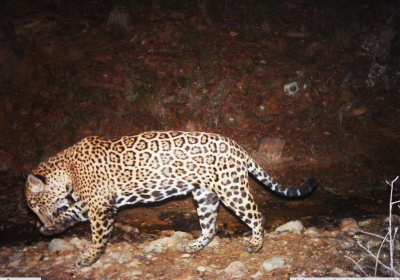By Catherine Swett.
Jaguars once ranged across a large portion of the United States, through California, Arizona, New Mexico, Texas, and even as far as Louisiana. But their numbers declined throughout the 20th century until they were only found in remote areas of Arizona and New Mexico. In the last two decades, only seven jaguars have been documented in the United States. And now their population faces a new threat—the Trump administration’s border wall.
Panthera onca

Jaguars have been listed as an endangered species in the United States since 1997, and they received designated critical habitat near the Arizona-Mexico border in 2014. While there are many threats to the species, habitat loss and fragmentation are some of the most significant. With smaller, scattered areas of habitat, jaguars’ prey is limited, it becomes harder for them to find mates, and they are more likely to encounter humans. Recognizing the importance of preventing habitat fragmentation, the Arizona Game and Fish Department’s Jaguar Conservation Program notes that “borderlands habitats must be managed in ways that provide . . . natural corridors that enable movement back and forth across political boundaries.”
A border wall would directly impact these natural corridors, fragmenting jaguar habitat even further. Most of the North American jaguar population is currently found in Mexico, but male jaguars migrate long distances to establish new territory. These are the jaguars that cross the border into Arizona. Indeed, all the jaguars recently documented in the state have been males. If the corridors they travel are blocked by a border wall, these big cats will be completely cut off from the rest of the breeding population. It would mean the end of the species in the United States.
Construction of a Border Wall
On February 15, 2019, President Trump signed the 2019 Consolidated Appropriations Act into law. However, dissatisfied with the $1.375 billion that Congress made available for the construction of a border wall, he invoked his authority under the National Emergencies Act (“NEA”) to divert $3.6 billion from military construction. The declaration of a national emergency allowed construction of the wall to begin without the usual restrictions imposed by environmental laws. In Sierra Club v. Trump, the Sierra Club, Southern Border Communities Coalition (“SBCC”), and multiple states challenged this appropriation of funds. The district court granted an injunction, stopping construction of the wall, which was then appealed to the Ninth Circuit.
While the main legal questions presented in Sierra Club v. Trump focused on the scope of the President’s powers, the potential for environmental harm played an important role in establishing standing for the plaintiffs. In order to sue, plaintiffs must show that they have suffered an injury that was caused by the defendant’s actions. The states and environmental advocacy organizations both relied on demonstrating that there was harm to wildlife to establish that they were injured by the border wall.
California argued that it has an interest in the natural resources and wildlife of the state, since they are held in trust for California residents. Because the proposed wall would impact a variety of wildlife habitats, the court was able to find sufficient injury to the plaintiffs. Similarly, New Mexico had standing in part because the border wall would harm the federally endangered jaguar. The court noted that a wall would “create fragmented habitat and block wildlife corridors for numerous protected species,” and it recognized that obstructing wildlife corridors is especially harmful to wide-ranging species like the jaguar, whose “survival depends on it being able to access habitat on both sides of the U.S.-Mexican border.”
The Sierra Club and SBCC also established standing to sue on behalf of their members because of the wall’s impact on wildlife. The court agreed that their “members obtain recreational, professional, scientific, educational, and aesthetic benefits from their activities along the U.S.-Mexico border, and from the wildlife dependent upon the habitat in these areas.” The overall impact on the environment and wildlife was therefore enough for the court to find that each organizations’ members would suffer a legally recognizable injury from the wall’s construction.
Once standing was established, the plaintiffs successfully argued that the Trump administration’s method of funding construction was unlawful. The Ninth Circuit affirmed the lower court’s ruling, halting construction of the border wall.
Continuing Habitat Protection
The court in Sierra Club v. Trump did not directly rely on the border wall’s environmental harm in holding its construction unlawful. But because it found that President Trump could not use his emergency powers to fund construction, the project can no longer avoid compliance with environmental laws. Borderlands species, including the jaguar, will continue to have some legal protections.
In a related border wall case involving the same parties, the Ninth Circuit again found the President’s funding of the wall unlawful. The Supreme Court recently granted certiorari, agreeing to hear the case during its current term.
